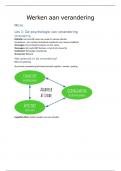Samenvatting
Mathematics 1 (2DD40) Summary Q1 2021
- Instelling
- Technische Universiteit Eindhoven (TUE)
EN: Mathematics 1 (2DD40) is a course taught at Eindhoven University of Technology. It is a mandatory course for Bachelor Industrial Engineering students. The course is given in the first quartile of the first year. Mathematics 1 discusses the basics of logic, sets, linear algebra, series and proba...
[Meer zien]













